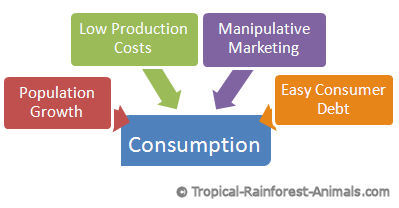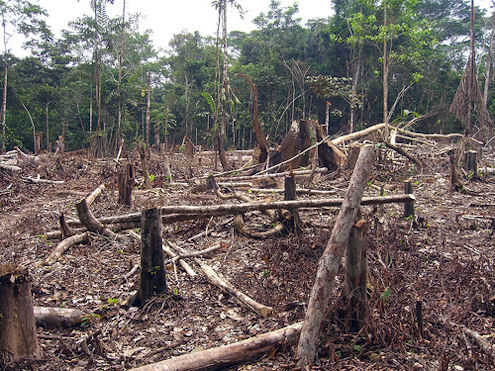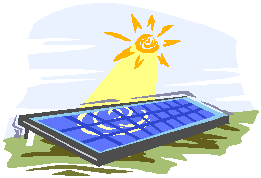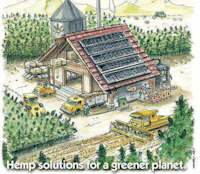How To Reduce Pollution: New And Old Ideas Alike
By Irina Bright.
This article is part of our Environment section
See the complete list of all our Pollution Articles here.
There are really many things each of us can do to help the environment. We discuss some old and new ideas on how to reduce pollution in the article below.
Let's start with some old ideas that have been floating around for a while now, on how to reduce global pollution.
Probably the most popular approach to pollution reduction officially adopted by most countries and their respective governments is technological advancement.
We hear everywhere that advanced technology is able to save us from the highly unpleasant and harmful pollution as we know it, and bring humanity into the future of clean environment and strong health & happiness for all.
I wrote about many technology-related ideas some time ago in the green investment article, and we discuss them later on in this article.
Using "green" technology can certainly help us to reduce the amount of pollution that is currently present in the environment.
However, I argue that, while we, of course, need to investigate all these fabulous technological opportunities, there is something far more important that every one of us, every individual can do - right at this moment, right from where we live, without waiting for a further second:
Reduce the levels of personal consumption.
How To Reduce Pollution
Solution No. 1: Reduce Personal Consumption
Problem No. 1: Personal Consumption.
 How to Reduce Pollution:
How to Reduce Pollution:Reduce Personal Consumption.
Not many people relate high levels of consumption to high levels of pollution.
I believe consumption is the very first step in the whole process of "pollution creation". This is exactly where the whole thing starts.
By creating demand for products, we - the ultimate consumers - initiate the process of production AND subsequent pollution that follows it.
I would identify several major trends that lie behind our consumption habits:
- Population Growth.
This is a general trend which is often mentioned by environmental activists as a major cause of pollution.
This is true, but with one caveat. Most of population growth currently takes place in developing countries while developed countries actually witness declines in population numbers. However, a LOT of pollution comes from developed countries whose use of natural resources is likely much higher than those of developing countries.
Nonetheless, we certainly need to keep an eye on global population numbers to make sure we don't exceed Earth's "carrying capacity".
In a way, population growth is somehow coupled with a concept of never-ending economic growth, which is simply not sustainable by any stretch of imagination.
- Low Production Costs.
Low prices for consumer goods mean that more people can afford more of them.
However, this is a sort of a classical "blessing in disguise" - most of such production cost savings are achieved: a) at the expense of the environment, and b) at the expense of cheap human labor mostly in developing countries. Neither of these invisible costs are factored into production costs and therefore enable very low consumer prices.
Obviously, low production costs mean that more goods can be manufactured using more of natural resources and then contributing to more waste pollution after such goods have been used up and discarded.
Most of cheap products are low in quality. So buying more expensive, higher quality goods is ultimately better for all stakeholders: consumers, labor and the environment itself.
- Manipulative Marketing Strategies.
Manipulative marketing that is thrown at us from all the directions effectively "forces" us to purchase and consume many useless products - the ones we don't really need.
There are thousands of products which we could easily do without - yet, they are being manufactured and marketed as a "must-have" for all.
Let's take toys as just one example. Children's marketing can be especially manipulative, as well as hard on parents' budgets. Children are often "encouraged" to press parents to buy an endless number of toys most of them don't need.
On top of that, plastic toys may contain a whole number of toxins which can affect children's health in the long-term. Once toys are thrown away, they often end up on a landfill and leak these toxins back into the environment.
- Easy Availability Of Consumer Debt.
As if over-production of cheap stuff was not already enough, there is a huge issue of easy availability of consumer debt which funds a big part of this over-consumption.
In the last decade or so, personal debt levels in a majority of western countries have truly sky-rocketed.
In many ways, this signifies not only an environmental tragedy, but also a personal tragedy for many families as well.
 How to Reduce Pollution:
How to Reduce Pollution: Reduce Deforestation.
© Threat to Democracy
Special Case: Books and Other Printing Materials.
But I would also like to mention a special case of goods which are manufactured from rainforest-extracted materials.
I am specifically talking about the manufacture of books and other printing materials.
We all love books and we all want our children to be well educated for their future life.
Despite that, health of the rainforests is certainly a big subject of this website, and I am really concerned about deforestation that is caused by production of printing materials.
Schemes, such as the one by the Forest Stewardship Council (FSC), which are supposed to certify "sustainable timber" for use in paper manufacturing, have been proven many times over to be just shams which usually end up green-washing ancient-rainforest destruction.
Why not try to switch to using digitally-stored books and other educational materials? All this technology is widely available these days, and we should try to use it to its maximum.
Next time we go shopping, let's think: do we really need a product that we are planning to buy, or can we do without it?
Please check out our article on pollution causes for further details on how personal consumption leads to higher levels of global pollution.
Based on the discussion in this section, here is our first solution on how to reduce pollution:
Solution No.1: Reduce Personal Consumption As Much As We Only Can.
How To Reduce Pollution
Solution No. 2: Shifting People's Consciousness Levels
Problem No. 2: Lack of Awareness That Personal Consumption Is A Major Cause of Pollution.
Most people seem to believe that technology is the only thing that can help us to reduce pollution levels.
But they don't quite think that our consumption (of everything) is actually the original cause of pollution, and if we reduce our consumption - it will automatically reduce pollution as well.
So what we need to do is try to push the humanity towards a tectonic shift in its collective consciousness, and increase awareness of the fact that:
Reduction in Consumption of Everything = Reduction in Pollution
Public education systems should play a major role in spreading the correct type of information - the concept that caring for the environment is 1,000 times more important than production of stuff we don't really need.
Educated populations will also hopefully push for stronger environmental regulations in their countries.
The recent advent of social networks such as Facebook and Twitter has also made it very easy for "people power" to help spread the knowledge and share ideas on how to improve the state of our environment.
Therefore:
Solution No. 2: Push Towards A Shift In People's Consciousness Levels.
How To Reduce Pollution
Solution No. 3: Use Clean Sources of Energy
Problem No. 3: Prevalent Use of Dirty Sources of Energy.
This problem is almost as old as time itself.
 How to Reduce Pollution:
How to Reduce Pollution: Use Clean Sources of Energy.
The use of dirty sources of energy - such as oil, gas & nuclear - has been forced down our throats for many years, with petroleum & nuclear industries actively lobbying against the introduction of clean sources of energy.
But, thankfully, we have recently seen a lot of research done into alternative sources of power. Most advances types of clean power are solar and wind energy.
Solar and wind are currently being widely introduced in many parts of the world, with some support from local governments.
A huge advantage of these two types of energy is that literally anyone can install a windmill or several solar panels in their backyard, or on the roofs.
I have also seen some innovative ideas being floated around about a possibility of installing large solar plants in sunny areas of the planet and then exporting this solar energy to other countries (ex., a project called DESERTEC).
There are endless possibilities here.
We should keep pressing for further expansion of green power into every part of our lives.
Solution No. 3: Use Clean Sources of Energy To Replace Dirty Ones.
How To Reduce Pollution
Solution No. 4 Introduce Eco-Friendly Raw Materials And Efficient Technologies
Problem No. 4: Wasteful Use of Raw Materials (Natural Resources) and Utilization of Inefficient Technologies.
This problem is very apparent not only in big industry, ex. huge power plants that use inefficient technologies to generate power, but specifically in our domestic lives as well.
There is a lot of "physical waste" and "wasted energy" present in our homes, to say the least.
 Hemp Building & Fields
Hemp Building & Fields How to Reduce Pollution:
Use Eco-Friendly Raw Materials Such As Hemp.
Courtesy of: Hemp For Life
Take, for example, packaging of foods that we eat every day. Most of such packaging is designed with the marketing purposes in mind, rather than from the point of view of conserving the environment.
Companies have to constantly compete against each other to "lure" customers, and beautiful packaging of consumer products is just the first step in this process. So they use lots of wrapping paper and print colors to "stay competitive" on the market. And while they do that - they certainly contribute towards environmental degradation along the way.
Most of the packaging that I have seen is useless and totally excessive.
Using recycled materials and minimizing the "size" of packaging is one way forward.
Inefficient use of energy at home is something we all, individually, can fix, even though just one step at a time.
Next time you go shopping for an electrical appliance, why not choose an energy-saving one? Why not try to remove all the "ghost electricity loads" in your house? I am talking about stand-by use of many common domestic devices. Putting TVs or anything else on stand-by consumes a lot of energy, which is pretty much energy wasted.
There can be a lot of improvement in the area of raw materials as well.
Let's have a look at construction raw materials used to build our homes.
Here is one example. By the start - middle of the 20th century, asbestos was widely used as a construction material in buildings, and as a raw material for various other industries. We now know that asbestos is a highly toxic material. Its mining can damage the surrounding environment, and health of people who come into close contact with it can be seriously affected.
You may be surprised to hear that one wonderful plant, hemp, is so strong that it can be used as a durable, eco-friendly construction material. Hemp has numerous other applications and many people now realize what a valuable resource it is for the future.
 Earthship in Brighton, UK.
Earthship in Brighton, UK. It is built with rubber tyres, uses solar panels, a windmill, and collects rainwater from the roof.
© Dominic Alves
Green buildings, in general, are a very interesting concept. They often encompass two things: a) architectural design which maximizes the use of natural sunlight and shade for heating and cooling purposes, and b) maximum utilization of recycled materials for constructing a building.
For example, I am fascinated by highly popular Earthships which originated from US and are now spreading around the world.
So what is "advanced technology" anyway?
By its very definition, advanced technology implies several things:
- Energy efficiency;
- Eco-friendly sources of energy, ex. solar and wind;
- Eco-friendly types of raw materials used in every imaginable industry;
- Eco-friendly consumer goods, ex. *green* cars;
- Recycling as much waste as possible using technologically new methods, and so on.
Therefore,
Solution No. 4: Introduce Eco-Friendly Raw Materials And Efficient Technologies.
How To Reduce Pollution
Solution No. 5: Recycling & Reforestation
Problem No. 5: Too Much Unrecycled Waste & Too Much Deforestation.
Recycling and reforestation play a special role in pollution reduction.
First of all, recycling is a straight-forward thing to do, and should really be done by everyone. Some more progressive nations, such as Sweden and Germany, recycle almost all of their waste while many other countries are still lagging behind.
This is the least we should be able to do - recycle our post-consumption waste.
Materials such as paper and tin are easily recyclable. Unfortunately, there are still many other types of waste which are hard, or impossible, to recycle, ex. plastic and styrofoam. There are some initiatives - ex., the Ellen MacArthur Foundation - which now push for introduction of 100% recyclable raw materials into every sphere of our lives.
 How to Reduce Pollution:
How to Reduce Pollution:Reforest Degraded Areas.
Recycling helps to prevent the potential damage to the environment.
Reforestation, on the other hand, mitigates the damage that has already been done before.
Reforestation, on a larger scale, can help restore global climate plus whole ecosystems that depend on the forests for their health.
On a smaller scale, at the very least, it can help reduce local pollution levels and provide local people with an opportunity to live in harmony with their environment.
Therefore,
Solution No. 5: Recycle Your Waste & Help Reforest Degraded Areas Around The Planet.
How To Reduce Pollution
Solution No. 6: Adopt Environmental Legislation and Improve Social Co-Operation
Problem No 6: Lack of Adequate Environmental Legislation & Weak Social Co-operation for Change.
Needless to say that, in order to succeed in our pollution reduction efforts, we have to get our governments to adopt the legislation that will put the environment at the very top - literally above everything else.
In 2010, in a very bold move Bolivia adopted a piece of groundbreaking legislation called The Law of the Rights of Mother Earth.
Bolivia's revolutionary approach here is that this law gives Earth and all its life systems a set of legal rights, or legal personhood. This may allow anyone to sue any other entity that is deemed to break the law in the future.
We should push other governments to adopt similar legislation as well.
We have to realize one simple thing - if we don't have adequate environmental services so generously delivered by the nature, we won't be able to live the life as we know it - no jobs, no food, no water, no clean air, nothing.
Another crucial point to understand is that we have to come together to save our planet, including incredibly valuable tropical rainforests, from future pollution and, in fact, from a potential complete destruction.
The co-operation between individuals, governments, businesses and non-profits should be deep at all levels - local, national and international.
Therefore,
Solution No. 6: Adopt Environmental Legislation & Improve Social Co-Operation.
At first glance, global pollution may look like a huge problem which is hard to solve.
However, I truly believe in the power of each individual to make a change if there is a real will to do so.
Let me finish this article by quoting Margaret Mead:
"Never doubt that a small group of thoughtful, committed citizens can change the world; indeed, it's the only thing that ever has."
Written by: Irina Bright
Original publication date: 2013
Republication date: 2020